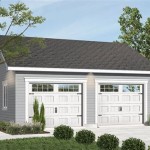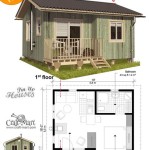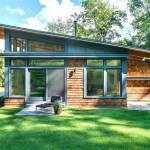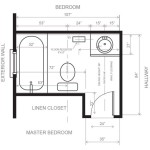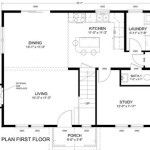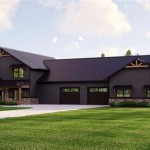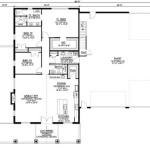Craftsman Style Cottage Floor Plans: A Detailed Exploration
Craftsman style cottage floor plans represent a harmonious blend of functionality, aesthetics, and a connection to nature. These floor plans are characterized by their efficient use of space, attention to detail, and an emphasis on handcrafted elements. Understanding the nuances of these designs requires examining their historical context, common features, and adaptability to modern living.
The Craftsman movement, which originated in the late 19th and early 20th centuries, was a reaction against the mass-produced, ornate designs of the Victorian era. It championed simplicity, honesty in construction, and the use of natural materials. This philosophy is directly reflected in Craftsman style cottage floor plans, which prioritize practicality and a close relationship between the interior and exterior environments.
Cottages, in general, are smaller, more informal dwellings that often evoke a sense of coziness and charm. When combined with the Craftsman aesthetic, the resulting floor plans typically feature open living spaces, efficient layouts, and a focus on natural light. This article will delve into the defining characteristics of these floor plans, exploring specific features such as the use of natural materials, the integration of outdoor spaces, and the common spatial arrangements.
Defining Features of Craftsman Style Cottage Floor Plans
Several key features distinguish Craftsman style cottage floor plans from other architectural styles. These elements contribute to the overall aesthetic and functionality of the home.
Emphasis on Natural Materials: The use of natural materials is a cornerstone of the Craftsman style. Wood, stone, and brick are commonly incorporated throughout the home, both structurally and decoratively. Exposed wooden beams, hardwood floors, and built-in cabinetry are frequently employed to showcase the natural beauty and warmth of the materials. Fireplaces, often crafted from stone or brick, serve as focal points in living areas, providing both heat and visual appeal. Exterior elements, such as cedar siding and stone foundations, further reinforce the connection to the natural environment.
Open Living Spaces: Craftsman cottage floor plans typically favor open living spaces, especially in the main areas of the home. The living room, dining area, and kitchen are often combined into a single, flowing space, promoting interaction and a sense of spaciousness. This open layout is conducive to both everyday living and entertaining. While open, these spaces often retain a sense of definition through the use of architectural details such as half-walls, columns, or changes in flooring material.
Built-in Features: Built-in furniture and storage solutions are prominent features of Craftsman interiors. Bookcases, window seats, and china cabinets are often integrated into the walls, maximizing space and adding to the home's character. These built-in elements not only provide practical storage but also contribute to the overall handcrafted aesthetic. The attention to detail in the design and construction of these features is a hallmark of the Craftsman style.
Low-Pitched Roofs and Wide Eaves: The exterior of a Craftsman cottage is typically characterized by a low-pitched roof with wide, overhanging eaves. These features provide protection from the elements and create a sense of shelter and security. The wide eaves also cast shadows that add depth and visual interest to the facade. Exposed rafter tails, often with decorative detailing, further enhance the Craftsman aesthetic.
Integration of Outdoor Spaces: Craftsman cottage floor plans often incorporate outdoor living spaces, such as porches, patios, and decks. These areas are designed to seamlessly connect the interior and exterior environments, allowing residents to enjoy the natural surroundings. Front porches, in particular, are a common feature, providing a welcoming space for relaxation and socializing. Back patios and decks offer private outdoor retreats for dining, entertaining, or simply enjoying the peace and quiet of the backyard.
Common Spatial Arrangements in Craftsman Cottage Floor Plans
The organization of space within a Craftsman cottage floor plan is carefully considered to maximize efficiency and comfort. While variations exist, certain patterns and arrangements are commonly observed.
One-Story Designs: Many Craftsman cottages are designed as one-story bungalows, offering ease of access and a compact footprint. These floor plans typically feature the main living areas in the center of the home, with bedrooms and bathrooms located on either side. The open living space often connects directly to the kitchen, creating a central hub for daily activities. One-story designs are particularly well-suited for aging in place, as they eliminate the need for stairs.
Two-Story Designs: While less common than one-story designs, two-story Craftsman cottages offer additional living space without significantly increasing the footprint of the home. In these designs, the main living areas are typically located on the first floor, while the bedrooms and bathrooms are situated on the second floor. This arrangement provides a clear separation between living and sleeping areas, enhancing privacy and quiet. The staircase, often crafted from wood with intricate detailing, serves as a focal point in the entryway or living room.
Bedroom Placement: The placement of bedrooms in a Craftsman cottage floor plan is often determined by the desire for privacy and quiet. In one-story designs, bedrooms are typically located at the rear of the house, away from the street. In two-story designs, bedrooms are generally situated on the second floor, providing a buffer from noise and activity on the main level. Master suites often include features such as walk-in closets, en-suite bathrooms, and private balconies or porches.
Kitchen Design: The kitchen is an integral part of a Craftsman cottage floor plan. It is typically designed to be functional and efficient, with ample counter space, storage, and natural light. Open kitchens, which flow seamlessly into the living and dining areas, are common features. Cabinetry is often crafted from wood and finished with a natural stain or paint. Details such as tile backsplashes, farmhouse sinks, and pendant lighting add to the kitchen's charm and character.
Bathroom Design: Bathrooms in Craftsman cottages are designed to be both functional and aesthetically pleasing. Tile is often used extensively, both on the floors and walls, providing a durable and easy-to-clean surface. Fixtures are typically chosen to complement the overall Craftsman aesthetic, with features such as claw-foot tubs, pedestal sinks, and vintage-inspired faucets. Natural light is often maximized through the use of windows and skylights.
Adapting Craftsman Style Cottage Floor Plans to Modern Living
While Craftsman style cottage floor plans are rooted in historical design principles, they can be successfully adapted to meet the needs of modern living. This involves incorporating contemporary features and technologies while preserving the essential characteristics of the Craftsman aesthetic.
Energy Efficiency: Modern Craftsman cottages often incorporate energy-efficient features such as high-performance windows, insulation, and HVAC systems. These technologies help to reduce energy consumption and lower utility bills, while also minimizing the home's environmental impact. Solar panels, rainwater harvesting systems, and other sustainable features can also be integrated into the design.
Smart Home Technology: The integration of smart home technology can enhance the convenience and comfort of a Craftsman cottage. Features such as smart lighting, thermostats, and security systems can be controlled remotely, allowing residents to manage their home's environment from anywhere. Voice-activated assistants and other smart devices can also be incorporated into the design.
Accessibility: Modern Craftsman cottages can be designed to be accessible to people of all ages and abilities. This involves incorporating features such as wider doorways, ramps, and grab bars. Universal design principles, which aim to create environments that are usable by everyone, can be applied to ensure that the home is both functional and comfortable for all residents.
Customization: While Craftsman style cottage floor plans provide a solid foundation, they can be customized to meet the specific needs and preferences of individual homeowners. This involves working with an architect or designer to create a floor plan that reflects the homeowner's lifestyle, taste, and budget. Customization can include changes to room sizes, layouts, and finishes, as well as the addition of unique features such as home offices, media rooms, or outdoor kitchens.
In conclusion, Craftsman style cottage floor plans offer a timeless blend of beauty, functionality, and connection to nature. Their emphasis on natural materials, open living spaces, and handcrafted details creates a warm and inviting atmosphere that is well-suited to both traditional and modern lifestyles. By understanding the defining characteristics of these floor plans and exploring the possibilities for adaptation and customization, homeowners can create a Craftsman cottage that is both beautiful and practical.

Small Craftsman Cottage Plan 94371 At Family Home Plans In Our Best Ing Floor Collection Style House

Traditional Style With 3 Bed 2 Bath Car Garage Planimetrie Di Case Da Sogno Planimetria Casa

3 Bedroom Craftsman Cottage House Plan With Porches

Modern Craftsman Plan Love This House Plans Sims Cottage

1925 26 C L Bowes House Plans Craftsman Style Vintage

Durham Drive Craftsman House Plans Ranch

Craftsman House Plans Home Floor Monster
:max_bytes(150000):strip_icc()/SL-1444_FCR-6feba1b011944212b854a6aabde38158.jpg?strip=all)
These One Story Craftsman House Plans Are Full Of Southern Charm

Craftsman Style Home Plans
:max_bytes(150000):strip_icc()/SL-1870_FCP-17f67fde84454f06aac8ab0f8056c01b.jpg?strip=all)
23 Craftsman Style House Plans We Can T Get Enough Of

